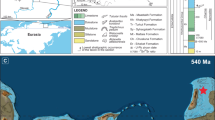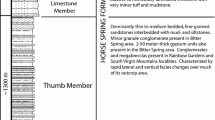Abstract
Classical biofacies models1,2 for reconstructing palaeoenvironments of strata deposited in oxygen-deficient marine settings define three principal facies: aerobic (> 1.0 ml 1−1 O2), dysaerobic (1.0 to 0.1 ml 1−1 O2) and anaerobic (<0.1 ml 1−1 O2) zones. These models have postulated a decrease in organism size and degree of calcification as well as a drastic reduction in the relative percentage of fauna possessing calcified skeletons as the dysaerobic/anaerobic boundary is approached. Through use of evidence independent of that provided by body fossils, we demonstrate here that in portions of the Monterey Formation (Miocene; California) the bivalve Anadara montereyana occurs in situ almost exclusively in strata deposited at the dysaerobic/anaerobic boundary. The occurrence of fossils of large well-calcified benthic macroinvertebrates at this redox boundary contradicts classical biofacies models1,2 and there-fore provides the basis for definition of a new oxygen-related biofacies, the 'exaerobic zone’. The exaerobic zone concept, when adjusted for differences in basin configuration and palaeoceano-graphic conditions, provides a potentially useful model for explain-ing occurrences of shelly benthic fossils within laminated, organic-rich strata of other Phanerozoic marine sequences.
Similar content being viewed by others
References
1.Rhoads, D. C. & Morse, J. W. Lethaia 4, 413–428 (1971). 2.Byers, C. W. Spec. Publs Soc. econ. Paleont. Miner. 25, 5–17 (1977). 3.Savrda, C. E. & Bottjer, D. J. Geology 14, 3–6 (1986). 4.Govean, F. M. & Garrison, R. E. in The Monterey Formation and Related Siliceous Rocks of California (eds Garrison, R. E. et al.) 181–198 (Spec. Publs Pacific Section, Soc. econ. Paleont. Miner., 1981). 5.Stanley, S. M. Mem. geol. Soc. Am.,125 (1970). 6. Aller, R. C. / Geol. 90, 79–95 (1982). 7. Mullins, H. T. et al. Geology 13, 491–494 (1985). 8. Hand, S. J. & Somero, G. N. Biol. Bull. 165, 167–181 (1983). 9. Felbeck, H. J. comp. Physiol. 152, 3–11 (1983). 10.Dando, A. J. et al. Mar. Ecol. Prog. Ser. 23, 85–98 (1985). 11. Reid, R. G. B. & Brand, D. G. Veliger, 29, 3–24 (1986). 12. Tunnicliffe, V. Nature 294, 354–356 (1981). 13.Savrda, C. E., Bottjer, D. J. & Gorsline, D. S. Bull. Am. Ass. Petrol. Geol. 68,1179–1192 (1984). 14. Thompson, J. B. et al. Lethaia 18, 167–179 (1985). 15.Jorgensen, B. B. & Revsbech, N. P. Limnol. Oceanogr. 30, 111–122 (1985). 16. Kauffman, E. G. in Communities of the Past (eds Gray, J., Boucot, A. J. & Berry, W. B. N.) 311–381 (Hutchison Ross, Stroudsberg, Pennsylvania, 1981). 17.Seilacher, A. Neues Jahrbuch fur Geologie und Paldontologie Monatshefte 98–114 (1982). 18. Seilacher, A. Proc. 1st Int. Meet, on Paleontology, Essential of Historical Geology Venice, 25–55 (1982). 19.Kauffman, E. G. The mount. Geologist 14, 75–99 (1977). 20. Hattin, D. E. Kans. geol. Surv. Bull. 225, 1–108 (1982). 21. Thayer, C. W. Lethaia 7, 121–155 (1974). 22.Heckel, P. H. Bull. Am. Ass. Petrol. Geol. 61, 1045–1068 (1977). 23. Sheehan, P. M. Lethaia 10, 201–203 (1977). 24. Watkins, R. & Berry, W. B. N. Lethaia 10, 267–286 (1977). 25. Morris, K. A. Paelaeogeogr. Palaeoclimatol. Palaeoecol. 26, 117–126 (1979). 26. Leggett, J. K. J. geol. Soc. Lond. 137, 139–156 (1980).
Author information
Authors and Affiliations
Rights and permissions
About this article
Cite this article
Savrda, C., Bottjer, D. The exaerobic zone, a new oxygen-deficient marine biofacies. Nature 327, 54–56 (1987). https://doi.org/10.1038/327054a0
Received:
Accepted:
Issue Date:
DOI: https://doi.org/10.1038/327054a0
- Springer Nature Limited
This article is cited by
-
Sedimentary deposits and bioturbation in an Early Cretaceous subarctic stormy greenhouse shelf environment
Environmental Earth Sciences (2023)
-
Calculating dissolved marine oxygen values based on an enhanced Benthic Foraminifera Oxygen Index
Scientific Reports (2022)
-
Ichnological data as a useful tool for deep-sea environmental characterization: a brief overview and an application to recognition of small-scale oxygenation changes during the Cenomanian–Turonian anoxic event
Geo-Marine Letters (2011)
-
An example for black shale development on a carbonate platform (late Triassic, Seefeld, Austria)
Facies (2001)
-
Periodic anoxic shelf in the Early-Middle Ordovician transition: ichnosedimentologic evidence from west-central Utah, USA
Science in China Series D: Earth Sciences (2001)





